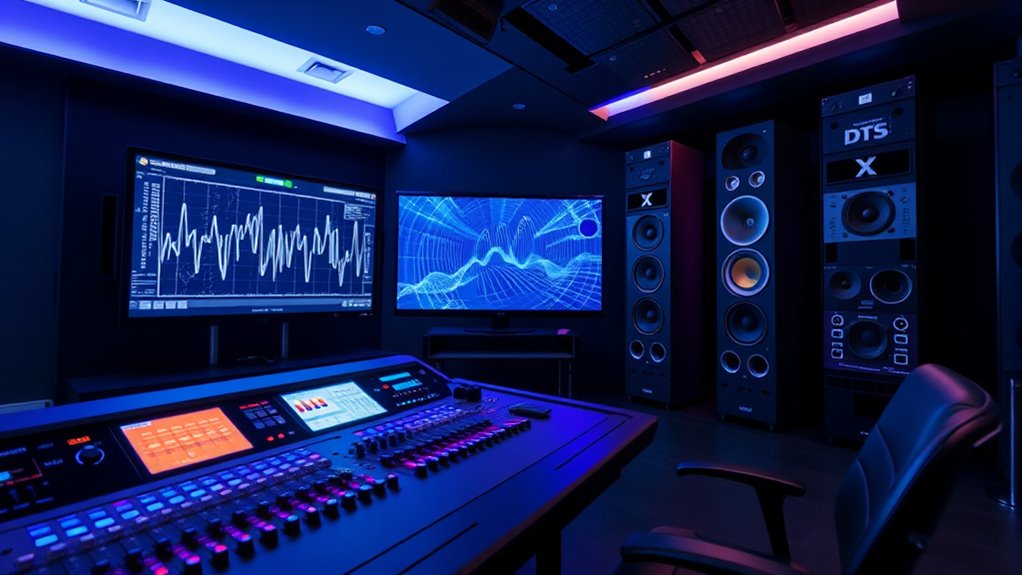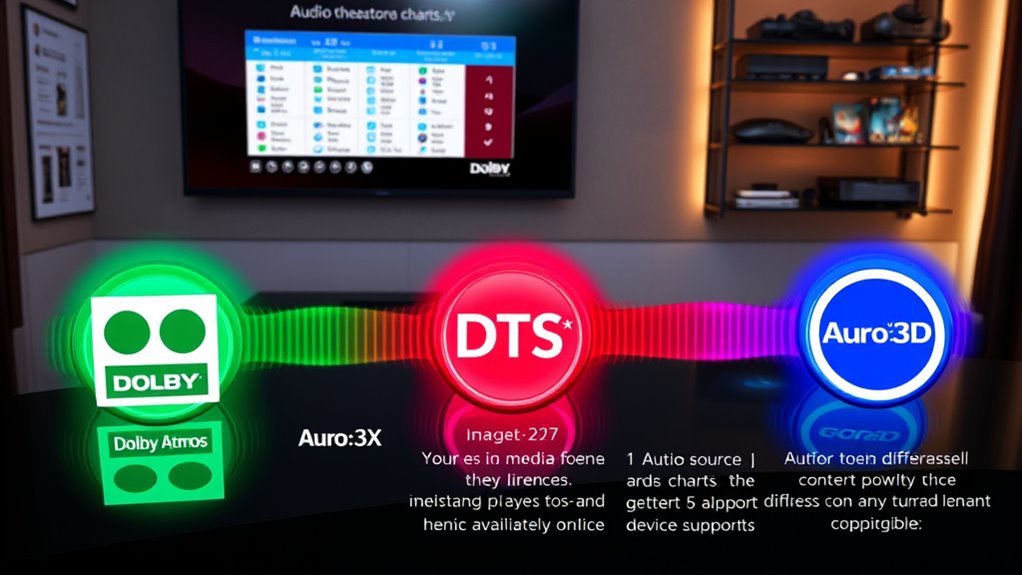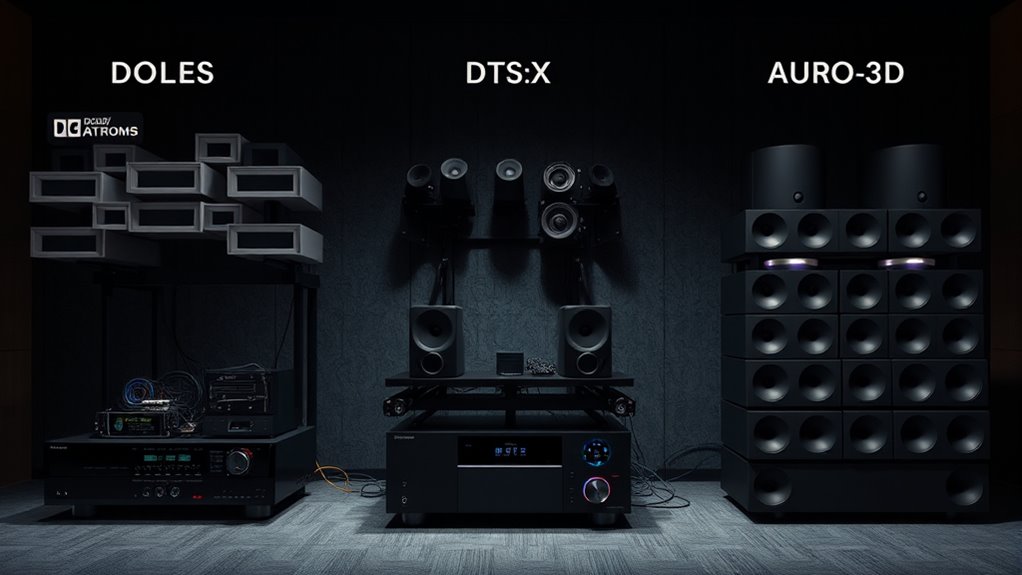Dolby Atmos, DTS:X, and Auro‑3d all provide immersive 3D audio experiences, but they differ in technology, compatibility, and content availability. Atmos is the most widely supported, offering extensive streaming and device options, while DTS:X is found on select platforms with some hardware limitations. Auro‑3d caters to high-end setups with a focus on realistic height channels. For a deeper understanding of their features and setup tips, keep exploring these formats.
Key Takeaways
- Dolby Atmos offers the broadest compatibility, extensive content, and seamless integration across devices, making it the most accessible 3D audio format.
- DTS:X provides more flexible object-based audio with less device support and is typically found on select Blu-ray discs and streaming platforms.
- Auro‑3d emphasizes a three-layer sound field with dedicated height and overhead speakers, mainly in high-end home theater systems.
- Dolby Atmos excels in music streaming and immersive content, while DTS:X and Auro‑3d have more limited content availability and device ecosystems.
- Proper system setup, including calibration and room acoustics, is critical for optimal experience across all three formats.
Core Technologies and Spatial Sound Rendering

Core technologies in 3D audio focus on creating a sense of space and directionality, making you feel immersed in the sound environment. Object-based audio plays a key role, allowing sound sources to be precisely placed anywhere in a three-dimensional space. Instead of channels, individual sound objects contain their own positioning data, which the system processes to produce a realistic sense of depth and localization. This approach makes the audio feel more lifelike and engaging. By accurately positioning sounds in a 3D environment, these core technologies transform passive listening into an active, enveloping experience that surrounds you with spatial clarity. Additionally, advancements in spatial sound rendering contribute to more seamless and natural soundscapes, further enhancing immersion. The development of dynamic audio processing techniques also helps adapt sound placement in real-time for more responsive and immersive experiences.
Compatibility and Content Availability

Are 3D audio formats widely compatible with your devices and available content? Not exactly. Dolby Atmos offers broad compatibility through streaming services like Apple Music and Tidal, plus support on many soundbars, AV receivers, and gaming consoles. DTS:X is also available on select platforms, including some Blu-ray discs and streaming apps, but its device support is more limited. Auro‑3d’s content is mostly found in high-end home theater systems and specialty equipment, making it less accessible for casual listeners. When it comes to music streaming, Dolby Atmos leads the way with more extensive catalog support. Headphone compatibility varies; Dolby Atmos works well with many headphones via compatible apps, while DTS:X and Auro‑3d may require specific hardware. Overall, your device ecosystem influences how easily you can access these formats. Additionally, content availability varies significantly among these formats, impacting how much you can enjoy them in your setup.
Setup and System Requirements

To enjoy 3D audio formats like Dolby Atmos, DTS:X, or Auro‑3d, you’ll need a compatible system that meets specific setup and hardware requirements. Start with speaker calibration to verify each speaker is correctly tuned for ideal sound placement and height channels. Proper calibration enhances immersion and clarifies audio cues. Additionally, room acoustics play a vital role; a space with minimal echo and balanced sound reflections will deliver better 3D audio performance. You may need to add or adjust speakers, such as overhead or ceiling-mounted units, depending on the format. A compatible AV receiver or processor that supports the specific 3D audio format is indispensable for decoding signals. Confirming these components are correctly configured guarantees a truly immersive experience. Incorporating sound quality enhancement techniques can further optimize your setup for the best immersive experience, especially as advances in AI in Business continue to improve audio processing technologies. Moreover, understanding self watering plant pots can help you maintain healthy indoor environments that support optimal acoustics and sound quality. Additionally, considering system compatibility ensures all components work seamlessly together to deliver the best possible audio experience. Proper network setup and streaming capabilities may also be necessary to access certain 3D audio content seamlessly.
Frequently Asked Questions
Which Format Offers the Best Immersive Experience for Gaming?
You want the best immersive experience for gaming, and spatial accuracy is key. Dolby Atmos often leads with precise sound placement and rich audio layering, making you feel surrounded by the action. DTS:X also offers excellent spatial cues and flexible audio layering, while Auro‑3D provides a more immersive vertical sound experience. Overall, Dolby Atmos tends to deliver the most compelling immersion for gaming, thanks to its superior spatial accuracy and detailed audio layering.
Do All Three Formats Support Streaming Services?
Not all three formats support streaming services equally. Dolby Atmos has broad streaming compatibility, and many services license Atmos content, giving you access to a wide range of immersive audio. DTS:X support is growing but still limited, depending on content licensing agreements. Auro‑3d is less common on streaming platforms, mainly found on physical media or specialized services. So, your streaming options depend on each format’s content licensing and platform support.
Can Existing Home Theater Systems Be Upgraded to Support These Formats?
You can upgrade your home theater system to support these formats, but be aware of compatibility challenges. Many modern AV receivers and speakers are compatible with Dolby Atmos, DTS:X, and Auro‑3D, making upgrades easier. However, older systems might need new hardware or additional components. Check your equipment’s specifications and consider professional home theater upgrades to guarantee seamless support for these immersive audio formats.
How Do These Formats Compare in Terms of Cost for Consumers?
You’ll find that pricing differences among 3D audio formats vary considerably. Dolby Atmos setup can cost $1,000 or more, including compatible receivers and speakers. DTS:X options are often more affordable, sometimes included in standard AVRs. Auro‑3D may require specialized equipment, increasing costs. Subscription costs for streaming content supporting these formats also differ, with Dolby Atmos generally commanding higher prices. Overall, your choice depends on your budget and the level of immersive sound you desire.
Are There Any Regional Restrictions for Accessing Content in Each Format?
You might encounter regional restrictions due to licensing agreements that limit content availability in certain areas. Regional licensing impacts which 3D audio formats you can access, as some services may only offer Dolby Atmos or DTS:X in specific countries. These restrictions can affect your listening experience, making it essential to check content availability in your region before investing in compatible hardware or subscriptions.
Conclusion
When choosing between Dolby Atmos, DTS:X, and Auro-3D, consider their core tech and content support. Dolby Atmos leads with over 2,000 streaming titles, making it the most widely available. Your setup’s complexity and compatibility also matter. Ultimately, selecting the right format depends on your preferences and system. If you’re looking for immersive sound, note that 70% of premium home theaters now support Atmos, highlighting its dominance in 3D audio experiences.















